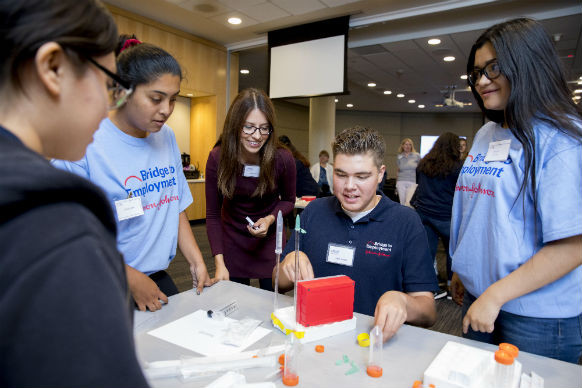In 1943, long before corporate social responsibility (CSR) became a catchphrase, Johnson & Johnson Chairman Robert Wood Johnson wrote the company’s now-famous “Our Credo,” which states that the company must be “responsible to the communities in which we live and work and to the world community as well.” While language like this is commonplace in corporate America today, when Johnson wrote those words, it was considered extraordinary for a company to put people before profit, and to claim that an obligation to help better society was embedded in its mission.
The very first line of that message states that meeting the needs of doctors and nurses is Johnson & Johnson’s first responsibility. In line with that goal, our employee secondment programs—which allow employees to work directly with our non-government organization (NGO) partners for up to six months—support the company’s larger focus on the global health workforce, especially health workers in developing countries who provide essential care for millions of people. We believe one of the best ways to advance global health is to ensure that health workers have the skills and resources they need to improve and save lives.

For example, in countries where the maternal and newborn death rate is very high, Johnson & Johnson funds programs that train birth attendants to manage complications arising from childbirth. In facilities where there are few or no doctors, these attendants are often the only health workers available to help women and their newborns. According to China’s National Maternal and Child Health Surveillance System, health attendants who participated in another Johnson & Johnson training program in China have saved more than 150,000 babies and reduced newborn death rates by 78 percent. And, earlier this year, we launched a new initiative in India called the Johnson & Johnson Institute on Wheels, which features a specialized bus that will serve as a mobile health center. The program will provide hands-on surgery training to approximately 25,000 doctors, nurses, and paramedical staff across 400 towns over the next five years.
The power of investing in people
We have spent decades supporting nonprofits and creating partnerships to change the trajectory of human health. Recognizing that many of our employees wanted to participate as well, we created our Talent for Good strategy to support various levels of employee engagement.
One of the many initiatives that are part of our Talent for Good employee engagement efforts is our Global Pro Bono program. In 2014, we chose 11 employees to participate in the first year of the program, and their enthusiasm was electric. Since then, we have offered employees in Europe, the Middle East, and Africa six-month assignments away from their jobs to work with nonprofits. And in the fall of last year, we presented employees in North and Latin America with the opportunity to share their skills and expertise with a nonprofit in their area. The participants’ personal stories are as inspiring as the local health outcomes they help create; they acquire new insights and feel a greater connection to our corporate mission, as well as an even stronger commitment to a healthy world for all.
Many of our social-impact programs go beyond clinical training. For instance, when Lisbon-based Johnson & Johnson employee Mariana Xavier spent six months in Nairobi working with the Aga Khan Development Network, she used her marketing and communication expertise to help empower midwives in Kenya to advocate for themselves and their profession on a national level. Johnson & Johnson also supports dozens of initiatives globally that enhance the leadership and management skills of health care administrators working with underserved populations.
Since essential health services come in many forms, we have learned to think broadly and explore new ideas that can help advance human health. In many communities, this means training mothers to be health mentors, since they are often closest to the people in most need, including their own family members. We are also educating microcredit loan officers to share important health messages with their clients. Our evaluations have found that these loan officers report greater job satisfaction as they help families in their communities invest in their health and their futures.
One of the greatest health risks facing developing countries today is the lack of qualified health professionals, especially in light of the growing burden of chronic diseases. To address this gap, Johnson & Johnson collaborates with numerous organizations and governments in more than 35 countries to help develop the next generation of frontline health workers.
One such initiative is our Bridge to Employment program, which aims to increase the number of students in underserved communities who enroll in higher education and pursue a career in the health sector. Since 1992, Johnson & Johnson employees have been actively involved in every aspect of the program, including design, partnership selection, and mentoring students. To date, we have introduced thousands of teenagers to various health-related careers, as well as exercises that help build their self-esteem, self-discipline, and interpersonal skills. Last year alone, 90 percent of program participants reported immediate plans to attend higher-education schools, and 50 percent reported plans to pursue a STEM-related career.
 San Diego high school students participating in the Johnson & Johnson Bridge to Employment program at Janssen Labs.
San Diego high school students participating in the Johnson & Johnson Bridge to Employment program at Janssen Labs.
Finally, we solicit ideas for innovation from the frontlines of health care. Last year, for example, we launched the first GenH Challenge, a global competition dedicated to unearthing new ideas that bring the world closer to the healthiest generation yet. After receiving more than 300 proposals for projects in 54 countries, we chose six winners. Winning ideas included a necklace that helps doctors ensure that a baby is up-to-date on vaccinations, and an affordable antibiotic that treats pneumonia and prevents malnutrition. Each of these winning ideas received funding from Johnson & Johnson, as well as mentorship from our executives.
Leveraging company assets for good
During a time when many multinational companies are trying to understand how to integrate the Sustainable Development Goals (SDGs) into their business strategies, “Our Credo” is more than a moral compass for Johnson & Johnson; we believe it is a recipe for business success.
Johnson & Johnson was among the first companies to announce a commitment to the SDGs, and we believe the talent and passion of employees are some of the greatest contributions the private sector can make to the international campaign. While funding is always an important factor in global health, our years of experience demonstrate the tremendous social and corporate value that comes from leveraging the full scope and strength of global operations.
Exploring investments beyond philanthropic dollars takes a thorough assessment of corporate assets and strengths. It also requires that we have a healthy commitment to collaboration, and to building meaningful partnerships with nonprofits, governments, intergovernmental agencies, and civil society.
A smart, skilled, and dedicated employee base has the power to create a ripple effect that can achieve important targets within the SDGs, and have a long-lasting and sustainable impact on the wider world. When considering the contributions private sector entities can make in achieving the SDGs, we must not overlook the talent and passion of employees. There is no time like the present to mobilize employees, engage local communities, and galvanize global partners to help change the course of your business, as well as human history.
Support SSIR’s coverage of cross-sector solutions to global challenges.
Help us further the reach of innovative ideas. Donate today.
Read more stories by Lauren Moore.

